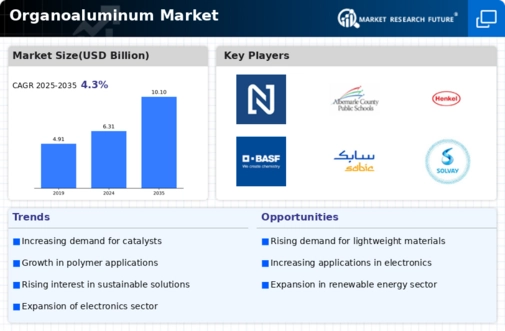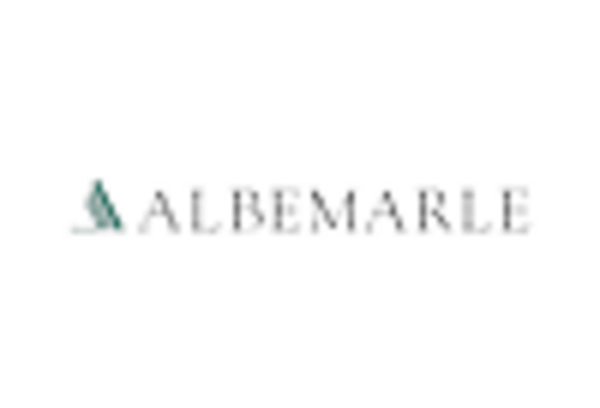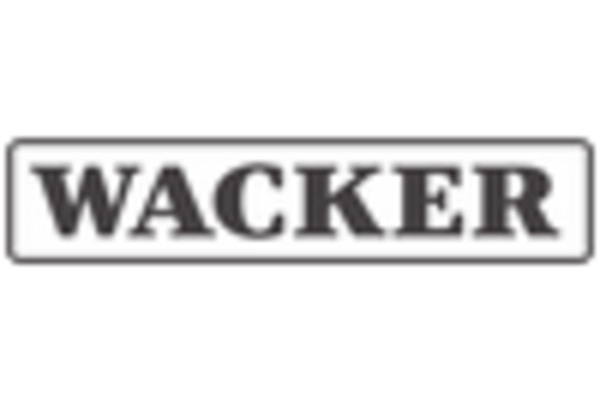Growth in Construction Activities
The Organoaluminum Market is significantly influenced by the expansion of construction activities across various regions. As urbanization accelerates, the demand for construction materials that offer durability and efficiency is on the rise. Organoaluminum compounds are increasingly used in construction applications, such as sealants and coatings, due to their superior properties. Recent statistics indicate that the construction sector contributes around 25% to the overall consumption of organoaluminum products. This trend is expected to continue as infrastructure projects gain momentum, particularly in developing economies. The increasing focus on sustainable building practices may also drive the adoption of organoaluminum materials, as they can enhance the longevity and performance of construction projects, thereby benefiting the Organoaluminum Market.
Rising Demand in Automotive Sector
The Organoaluminum Market is experiencing a notable surge in demand from the automotive sector. This increase is primarily driven by the growing need for lightweight materials that enhance fuel efficiency and reduce emissions. Organoaluminum compounds are utilized in various applications, including coatings and adhesives, which are essential for modern vehicle manufacturing. According to recent data, the automotive industry accounts for approximately 30% of the total demand for organoaluminum products. As manufacturers strive to meet stringent environmental regulations, the adoption of organoaluminum compounds is likely to expand, thereby propelling the market forward. Furthermore, the trend towards electric vehicles, which require advanced materials for battery production, further underscores the potential growth within the Organoaluminum Market.
Expanding Applications in Electronics
The Organoaluminum Market is experiencing growth due to the expanding applications in the electronics sector. Organoaluminum compounds are increasingly utilized in the production of semiconductors and electronic components, owing to their unique properties that enhance performance and reliability. The electronics industry is projected to account for approximately 20% of the total organoaluminum consumption. As technology continues to evolve, the demand for high-performance materials in electronics is likely to increase, further driving the growth of the Organoaluminum Market. Additionally, the rise of smart devices and the Internet of Things (IoT) is expected to create new opportunities for organoaluminum applications, thereby contributing to the overall market expansion.
Increasing Focus on Sustainable Solutions
The Organoaluminum Market is witnessing a shift towards sustainable solutions, driven by growing environmental concerns. Industries are increasingly seeking eco-friendly alternatives to traditional materials, and organoaluminum compounds are emerging as viable options due to their lower environmental impact. The demand for sustainable products is reflected in the rising interest in organoaluminum applications in renewable energy sectors, such as solar panels and wind turbines. Recent market analyses suggest that the sustainable segment of the organoaluminum market could grow by 7% over the next five years. This trend indicates a potential transformation in the Organoaluminum Market, as companies align their strategies with sustainability goals and regulatory requirements.
Technological Innovations in Manufacturing
Technological advancements play a crucial role in shaping the Organoaluminum Market. Innovations in manufacturing processes, such as improved synthesis techniques and enhanced purification methods, are leading to higher quality organoaluminum products. These advancements not only increase production efficiency but also reduce costs, making organoaluminum compounds more accessible to various industries. For instance, the introduction of automated systems in production lines has streamlined operations, resulting in a projected growth rate of 5% annually for the organoaluminum market. As manufacturers continue to invest in research and development, the Organoaluminum Market is likely to benefit from the introduction of novel applications and improved product performance.


















Leave a Comment